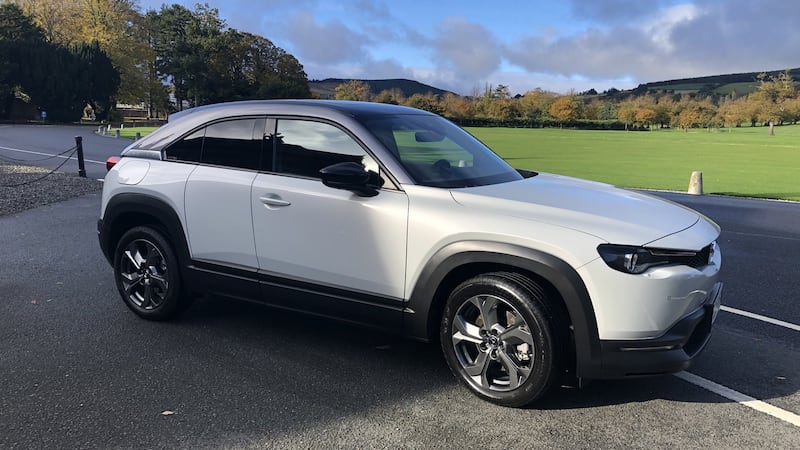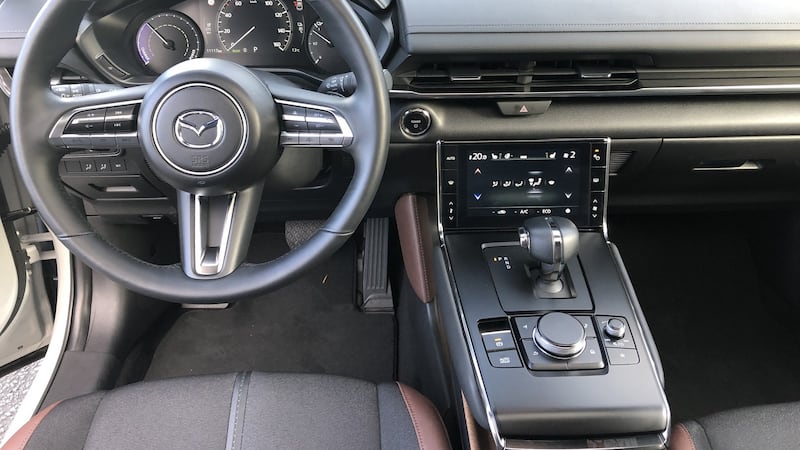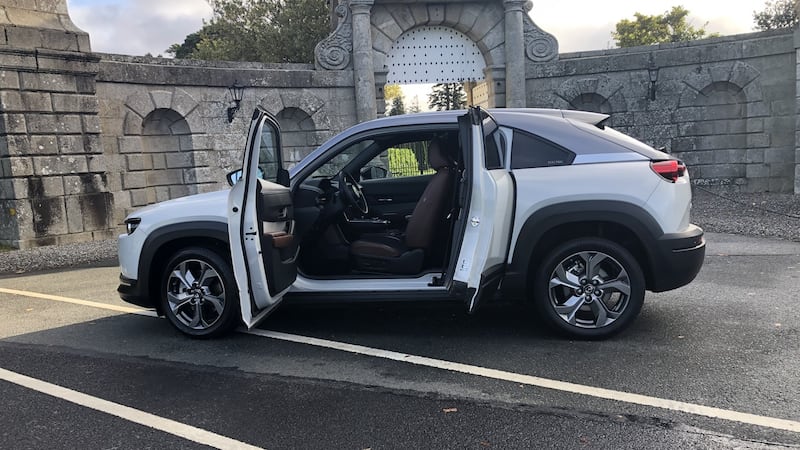It took us slightly less than a century to go from creating, and then loving, the car, from constantly upgrading its power and performance to realising that – hang on a tick – maybe we need to make these things a bit less weighty on our pocket, and indeed on the planet around us. In 1973, the first oil crisis took a firm grip of the global economy, and made us start to think that maybe all this burning of dead dinosaurs wasn’t such a hot idea after all.
It was during those 1970s OPEC fun-fests that the first modern electric cars started to emerge from design labs and prototype works. Mazda, way back then, got in on the act (actually doing so before the first oil crisis) by showing off its EX-005 prototype in 1970. This was, effectively, a bubble with wheels and owed more to The Jetsons (ask your grandad) than any realistic vehicle. Fifty years on, and in the midst of yet another environmental crisis, we have our first on-sale Mazda EV.

It’s this, the MX-30 (MX standing for Mazda eXperimental, in case you were wondering) and it’s a relatively conventional-looking crossover, powered by batteries, with a 145hp electric motor doing the driving. So far, so pretty much new-normal – all carmakers are rushing to get EVs on sale, cognisant of both the enveloping climate crisis and the EU’s ever-stricter CO2 emissions regulations.
Hang on though, half the battery appears to be missing. Mazda quotes a battery capacity for the MX-30 of 35.5kWh. To put that in perspective, a compact Opel Corsa-e hatchback has a 50kWh battery. You can't buy a Nissan Leaf with less than 40kWh capacity, and Hyundai doesn't even bother to sell a Kona Electric with less than a 62kWh battery. Battery capacity equals range, because of course it does. So Mazda will be putting its brand spanking new MX-30 EV on sale with a WLTP-certified range of 200km, or about 265km if you're driving exclusively around town. That would be the equivalent of Porsche putting a brand new 911 on sale with a 165hp engine in the back. Or possibly Volvo selling a car with no airbags.
'Race for range'
Or would it? Mazda’s contention is that the “race for range” (Mazda’s phrase, not ours) is actually doing more harm than good, and that we need to rethink our youthful relationship with the electric car. The thinking is this – yes, electric cars have no local emissions when you drive them but their batteries cause CO2 to be emitted during their manufacture. The bigger the battery, the more CO2 is emitted, which is surely missing the point of EVs entirely. Research shows that while electric cars have lower lifetime emissions than a petrol or diesel car, you have to drive them a lot to hit the break-even point in terms of total emissions. Compare the emissions taken to make the battery to the emissions of running a conventional engine and that crossover point occurs at about 50,000km.
Mazda contends that the manufacturing of its smaller battery causes lower CO2 emissions, and so drastically reduces that crossover point.

"Every electric car is, effectively, carrying around a backpack of emissions with it when it's built" Mazda Ireland's product and marketing specialist, David Bannon, told The Irish Times. "We've just made our backpack smaller."
The logic, when you sit and think about it, is compelling. Assuming your electricity comes from a relatively low-emitting network (and Ireland’s is improving all the time in that regard) all you have to do is top up your smaller battery more often, and you’re – overall – causing less climate-changing gas to be emitted, even compared to your neighbour and their shiny new big-battery car.
Of course, car buyers don't usually think like that. While Mazda is technically right that all the extra range (and manufacturing emissions) of a bigger battery tends to go to waste, and sits uselessly on a driveway somewhere, the fact is that a car is a big expense, and most of us expect our cars to perform multiple roles. Yes, for 99 days out of 100 we just potter about for a few kilometres at a time, but on the 100th day, we might fancy a drive to Belmullet. Until the national public charging network improves dramatically, that is going to be trickier in an MX-30, although Mazda insists that time spent with the car reveals that it's rather more adaptable to such situations than the raw numbers suggest.
Coupe-ish styling
Of course, another benefit of the smaller battery is price. The MX-30 is a chunky, four-seat crossover with coupe-ish styling and cool rear-hinged doors meant to remind us of the old RX-8 sports car. It's priced, once you work in the grants and the recent changes to the VRT system, from about €30,500 (give or take – final, final pricing is still being signed off) which, in bigger battery models, would get you a well-equipped Peugeot e-208. The French hatch will go farther on a charge, but the Mazda looks and feels like a much more substantial vehicle.

It also feels good to drive. Mazda says that it didn’t want its traditional driver-oriented feel to get subsumed by the electric tech, and it’s more or less succeeded. The steering feels balanced and eager, the chassis is nicely set-up, albeit with a slightly over-firm ride around town. There’s none of the Tesla-style instant-oomph feeling from the 145hp motor, and its 270Nm of torque flows in smoothly. It feels much more linear in its power delivery, but doesn’t lack for outright punch, certainly less so than you’d assume from the on-paper performance. Of course, it’s smooth but the manufactured in-car noise, a mixture of Star Trek-y whoosh and synthesised engine note, needs an off switch as it does blunt the inherent refinement.
Cabin quality is predictably unimpeachable, and the materials – including plastics and fabrics made from recycled PET bottles – look and feel great. Mildly less successful is cork – yes, cork – trim. Mazda, which celebrates its 100th birthday this year, started life as a company that made cork panels and fittings, mostly for ships, taken from the abundant cork trees around its home town of Hiroshima. It’s an intriguingly tactile material for the inside of a car, and certainly makes a change from lacquered wood, but you worry that inquisitive, fidgeting fingers will, over time, pick bits of it off. In terms of space, the MX-30 doesn’t do so well, either. The boot is a mere 366-litres, while the rear seats, accessed via those cool rear doors, feels a touch tight.
Will buyers take to the MX-30? Possibly. . . the price point is tempting, especially given the bigger-car-for-less-cash-than-the-competition aspect. But people, right now, really do by electric cars based on their range, and the greater the range, the easier the sale. The lower entry price is also slightly knocked back by the fact that bigger-battery rivals offer tempting finance rates.
From an engineering perspective, from a logical standpoint (which are effectively the same thing) I can see and appreciate exactly what Mazda is doing, and it’s more or less certainly right. We need to look at the total life emissions of an electric car, not just the fact that it emits nothing at the point of use. But, right now, buyers just don’t think like that, and until the education hits home, or until there’s a fast-charger on every corner, that’s probably not going to change.










